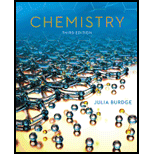
Interpretation:
The value of
Concept introduction:
The
Here,
The value of
Here,
The value of
The relationship between kilojoules and joules can be expressed as:
To convert kilojoules to joules, conversion factor is
Answer to Problem 63QP
Solution: The values of
Explanation of Solution
Given information: The given reaction is
The value of
The value of
The value of
The value of
Here,
The value of change in standard Gibbs free energy for atoms in their standard state is zero. In the reaction,
Substitute
Therefore, the value of
The value of
The value of
Here,
Substitute
Therefore, the value of
In the given reaction, the number of moles of gaseous atoms is two on both sides of the reaction, and thus there is no change in the number of moles.
Hence, the value of
The value of
Want to see more full solutions like this?
Chapter 24 Solutions
Student Study Guide for Chemistry
- Actually, the carbon in CO2(g) is thermodynamically unstable with respect to the carbon in calcium carbonate(limestone). Verify this by determining the standardGibbs free energy change for the reaction of lime,CaO(s), with CO2(g) to make CaCO3(s).arrow_forwarda Calculate K1, at 25C for phosphoric acid: H3PO4(aq)H+(aq)+H2PO4(aq) b Which thermodynamic factor is the most significant in accounting for the fact that phosphoric acid is a weak acid? Why ?arrow_forwardAdenosine triphosphate, ATP, is used as a free-energy source by biological cells. (See the essay on page 624.) ATP hydrolyzes in the presence of enzymes to give ADP: ATP(aq)+H2O(l)ADP(aq)+H2PO4(aq);G=30.5kJ/molat25C Consider a hypothetical biochemical reaction of molecule A to give molecule B: A(aq)B(aq);G=+15.0kJ/molat25C Calculate the ratio [B]/[A] at 25C at equilibrium. Now consider this reaction coupled to the reaction for the hydrolysis of ATP: A(aq)+ATP(aq)+H2O(l)B(aq)+ADP(aq)+H2PO4(aq) If a cell maintains a high ratio of ATP to ADP and H2PO4 by continuously making ATP, the conversion of A to B can be made highly spontaneous. A characteristic value of this ratio is [ATP][ADP][H2PO4]=500 Calculate the ratio [B][A] in this case and compare it with the uncoupled reaction. Compared with the uncoupled reaction, how much larger is this ratio when coupled to the hydrolysis of ATP?arrow_forward
- What information can be determined from G for a reaction? Does one get the same information from G, the standard free energy change? G allows determination of the equilibrium constant K for a reaction. How? How can one estimate the value of K at temperatures other than 25C for a reaction? How can one estimate the temperature where K = 1 for a reaction? Do all reactions have a specific temperature where K = 1?arrow_forwardCalculate the free energy change that occurs when a reaction has an enthalpy of −315.2 kJ mol−1 and an entropy change of 224.7 J mol−1 K−1 at 211.3 ∘C. What is the equilibrium constant for this reaction at this temperature? Will that constant increase or decrease as the temperature is increased?arrow_forward1. If Q < K, which way will the reaction proceed and why?arrow_forward
- The standard free energy of formation, DGf°, of atomic oxygen is 230.1 kJ/mol. Determine the equilibrium constant for the following reaction at standard thermodynamic conditions. O2(g) ↔ 2O(g)arrow_forwardWhich of the following statements is true? Select one: At equilibrium, K = 0. If K > 1, the reaction is spontaneous in the reverse direction under standard conditions. For an endothermic reaction, increasing the temperature will increase the value of K. If K = 1×109, equilibrium favours the reactant side. At equilibrium, the concentrations of the reactants are always equal to the concentrations of the products.arrow_forwardFor a certain chemical reaction, the standard Gibbs free energy of reaction at 15.0°C is −143. kJ. Calculate the equilibrium constant K for this reaction.arrow_forward
 Chemistry: The Molecular ScienceChemistryISBN:9781285199047Author:John W. Moore, Conrad L. StanitskiPublisher:Cengage Learning
Chemistry: The Molecular ScienceChemistryISBN:9781285199047Author:John W. Moore, Conrad L. StanitskiPublisher:Cengage Learning General Chemistry - Standalone book (MindTap Cour...ChemistryISBN:9781305580343Author:Steven D. Gammon, Ebbing, Darrell Ebbing, Steven D., Darrell; Gammon, Darrell Ebbing; Steven D. Gammon, Darrell D.; Gammon, Ebbing; Steven D. Gammon; DarrellPublisher:Cengage Learning
General Chemistry - Standalone book (MindTap Cour...ChemistryISBN:9781305580343Author:Steven D. Gammon, Ebbing, Darrell Ebbing, Steven D., Darrell; Gammon, Darrell Ebbing; Steven D. Gammon, Darrell D.; Gammon, Ebbing; Steven D. Gammon; DarrellPublisher:Cengage Learning Chemistry & Chemical ReactivityChemistryISBN:9781133949640Author:John C. Kotz, Paul M. Treichel, John Townsend, David TreichelPublisher:Cengage Learning
Chemistry & Chemical ReactivityChemistryISBN:9781133949640Author:John C. Kotz, Paul M. Treichel, John Townsend, David TreichelPublisher:Cengage Learning Chemistry & Chemical ReactivityChemistryISBN:9781337399074Author:John C. Kotz, Paul M. Treichel, John Townsend, David TreichelPublisher:Cengage Learning
Chemistry & Chemical ReactivityChemistryISBN:9781337399074Author:John C. Kotz, Paul M. Treichel, John Townsend, David TreichelPublisher:Cengage Learning
 Chemistry: An Atoms First ApproachChemistryISBN:9781305079243Author:Steven S. Zumdahl, Susan A. ZumdahlPublisher:Cengage Learning
Chemistry: An Atoms First ApproachChemistryISBN:9781305079243Author:Steven S. Zumdahl, Susan A. ZumdahlPublisher:Cengage Learning





